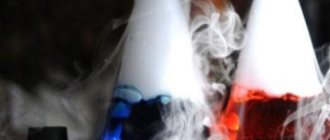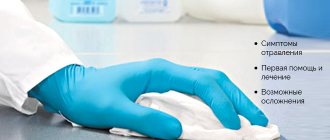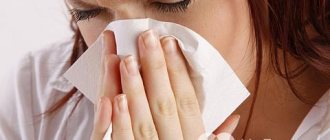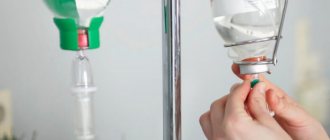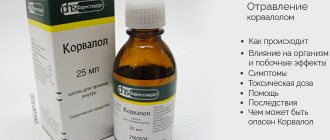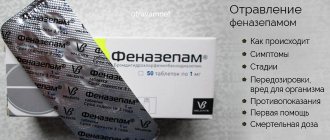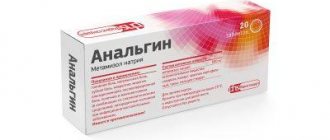The vast majority of victims of poisoning make the same mistakes, sometimes only aggravating an already serious situation, which can result from a “chemical injury” received during acute poisoning.
We continue the joint project of our newspaper and the Moscow Ambulance and Emergency Medical Service, begun in previous issues.
A word from the anesthesiologist-resuscitator of the specialized mobile resuscitation team, Anatoly Murashov .
Acute poisoning is a difficult test for the body. According to statistics from the Moscow Ambulance Service, by the time doctors arrived at such patients, coma was observed in approximately 35–40%, disturbances in blood pressure and heart rate (up to the development of heart block and cardiac arrest) – in 35–40% of those poisoned . You cannot do without urgent medical care here.
Article on the topic
My stomach was churning! How to distinguish poisoning from an intestinal infection
Low toxic plants
Eating low-toxic plants is not life-threatening, but leads to a number of unpleasant consequences: digestive system upset, diarrhea, weakness, vomiting, trembling. Low-toxic plants include representatives of the amaryllis family, which contain lycorine or other toxic alkaloids: amaryllis, hymenocallis, hemanthus, hippeastrum, zephyranthes, crinum, clivia, nerine, eucharis. Many other plants are also low-toxic: aloe, geranium, gardenia, dracaena, Kalanchoe calamondin, cordilina, strelitzia, yucca. However, there are many beautiful house plants that do not pose any health hazard: orchids, gloxinias and other representatives of the Gesneriaceae family, Usambara violets, hibiscus, various types of succulents. The listed plants can be safely used to create a home collection.
Rehabilitation
After diagnosis and treatment, a rehabilitation period will be required. Restoring the body after poisoning is based on taking medications and diet.
- The patient must observe therapeutic fasting. Initially, you can only drink water. If you feel better, you can take rice water.
- From the 2nd day, a 2-week therapeutic diet begins. Meals are allowed in small fractional portions. Food should be light and low in calories. The diet expands gradually, and initially it includes only low-fat, grated and steamed food. After a couple of weeks, you can add fresh fruits and vegetables to your diet to ensure you are getting the nutrients you need.
- Additionally, medications and probiotics are prescribed to restore the gastrointestinal tract and strengthen the immune system after the situation.
Acute food poisoning, just like chemical poisoning, requires mandatory consultation with doctors for effective treatment, followed by rehabilitation and complete restoration of the body.
Dangerous street plants
The plants listed below are unpretentious, and therefore are found more often than others. After interacting with any of them, a person will urgently need first aid.
- Aconite . Causes convulsions, dizziness, loss of consciousness;
- Belladonna . Causes nausea, dizziness, hallucinations, convulsions and even death.
- Datura common. Causes the same reactions as belladonna.
- Crow's eye . Leads to speech disorder, convulsions, and depression of cardiac activity.
- Field bindweed. After poisoning, nausea and abdominal pain appear.
- Larkspur field . Signs of poisoning include difficulty breathing and a drop in blood pressure, convulsions, and cardiac dysfunction.
- Foxglove . After taking it, stomach upset occurs, swelling and extraordinary contractions of the heart muscles appear.
- Male fern . Signs of poisoning are indigestion, convulsions, blurred vision, depression of cardiac activity.
- Dream-grass. Affects the gastrointestinal tract, disrupts kidney function, causes convulsions and breathing problems.
- Spore. Leads to severe pain, seizures and even death.
- Hemlock . Causes dizziness, convulsions, thirst, paralysis of the respiratory center.
- Lobel's hellebore. Symptoms of poisoning include upset stomach, slow breathing and pulse, and blurred vision.
- Great celandine. Causes paralysis of sensory and nerve endings.
First aid for plant poisoning is to rid the victim’s body of the poison. The sooner this happens, the less serious the consequences will be.
Medications
How dangerous. With inadequate drug therapy, which is resorted to by fans of self-medication, any drug can cause acute poisoning. Even seemingly harmless aspirin, which, if the therapeutic dose is exceeded, can cause acute renal failure, contribute to the development of stomach and duodenal ulcers, bleeding and even damage to the auditory nerve. Toxicologists also have analgesics and non-steroidal anti-inflammatory drugs (paracetamol, nurofen), antibiotics, and psychotropic drugs (hypnotics, antidepressants) on their “black” list.
Article on the topic
To help the stomach. Remedies that improve well-being after poisoning
What to do before the ambulance arrives. It is allowed to take activated charcoal (the sooner the better), put the person to bed and measure his blood pressure and pulse.
How to take activated carbon →
Attention! Often medications are taken for the purpose of suicide. If the tablets have just been swallowed, before the ambulance arrives, you can induce artificial vomiting and then give the victim activated charcoal. Also try to find out what drug the person took and in what dose.
Vomiting should not be induced if the victim:
- unconscious;
- in a state of convulsions;
- has heart disease;
- pregnant woman or child under 5 years old.
If you find a person unconscious and suspect he has been poisoned, then nothing should be done before the ambulance arrives except to prevent tongue retraction, which can cause obstruction of the airway and aggravate the general condition of the victim. To prevent this from happening, you need to carefully turn the person on his side, and to fix this position, bend the overlying leg at the knee and hip joints, and the arm at the shoulder and elbow.
It is also not recommended to take large amounts of liquid after carelessly taking the drug in the hope of inducing vomiting. By doing this, you will only speed up the resorption (absorption) of a dangerous drug and will not always be able to achieve the desired result.
Food poisoning: how to recognize botulism and neutralize toxins
More details
Symptoms of plant poisoning
First aid to an injured person is the same in all cases - ridding the body of poison. However, the effect of poisonous plants on the body causes different reactions depending on which organs they affect:
- Nervous system. Symptoms of poisoning are convulsions, agitation, dilated pupils, nervous itching, manic disorder.
- Gastrointestinal tract. Symptoms are vomiting, diarrhea, which is explained by the body’s attempts to remove harmful substances.
- Heart. When poisoned by poisonous plants that affect the heart, cardiac dysfunction occurs: alternating strong heartbeat with freezing, a sharp drop in blood pressure.
- Liver. Ingestion of poisonous plants leads to loss of appetite and indigestion, nausea, and pain in the right hypochondrium.
- Leather. Burns and dermatitis occur when skin is exposed to certain plants, and some essential oils can be harmful to the skin or mucous membranes.
The appearance of any of these signs is a sign that the victim urgently needs first, and subsequently, medical care.
What to do after vomiting
After completely emptying the stomach of food residues, you always feel severe weakness and dizziness. To help your body recover properly:
- Rinse your mouth with clean water. Even if there are no food particles left in the mouth, gastric juice may remain on the surface of the mucous membrane, which will cause additional irritation. For this reason, you should not brush your teeth earlier than half an hour after vomiting - otherwise the acid will damage the tooth enamel.
- Drink a decoction of medicinal herbs. After vomiting, chamomile and ginger tea, lemon balm or fennel infusion are especially useful. The drink should be warm, but not hot; You can add a little flower honey to it.
- When you feel an appetite, eat a light dish - yogurt, oatmeal, banana, baked apple. For the next 1–2 days, it is advisable to adhere to a gentle diet to speed up the recovery of the digestive tract. During this period, refrain from smoking, spicy and sour foods, as well as drinking alcohol.
Be sure to give your body a rest.
First aid for poisoning
If a person accidentally eats poisonous plants, first aid should be provided as quickly as possible. The main thing that needs to be done is to remove the poison from the body, which requires inducing vomiting. This is done in the following way:
- give the victim a few glasses of water with dissolved salt;
- Use the handle of a spoon or your finger to press the root of the victim’s tongue to induce vomiting;
- repeat these first aid techniques several times to completely rid the stomach of poison;
- give the victim any adsorbent drug (usually activated carbon is used - 1 tablet per 10 kg of weight);
- after a few hours, rinse the victim’s stomach again or give a laxative.
First aid for poisoning by poisonous plants is only part of the necessary set of measures. After performing emergency actions, the victim should be transported to the hospital as quickly as possible. This needs to be done especially urgently in case of severe poisoning by plants that affect the heart and nervous system. Remember the symptoms of poisoning described in the article and the rules of first aid - this knowledge can be invaluable and literally save a person’s life in a dangerous situation.
You can order a Lechuza flowerpot with automatic watering or a terrace landscaping service by calling: (vel) +375(029) 171 94 42; (mts) +375(029) 503 80 17, and we will also provide the necessary advice. Contact us !
Leave a request or
Alcohol
Acute ethyl alcohol poisoning is often accompanied by loss of consciousness caused by drinking an unusually large amount of alcohol-containing drinks for the victim. The situation is almost always complicated by vomiting and increased salivation.
How dangerous. Death from suffocation as a result of tongue retraction and/or vomit entering the respiratory tract.
What to do before the ambulance arrives. The only thing that can be done in this situation is to place the person on his side to prevent the tongue from retracting, as well as vomit and saliva from flowing into the respiratory tract.
Is beer worse than vodka? TOP 5 most dangerous alcoholic drinks
More details
The effect of opiates on humans
Opium alkaloids act on specific opiate receptors, causing powerful pain relief. This is their therapeutic effect, used to relieve severe pain.
In addition to relieving pain, the drug creates euphoric experiences in a person:
- A surge of many pleasant sensations.
- Relaxation.
- Unreasonable joy.
Phases of anesthesia:
- In the language of drug addicts - “arrival”. The first sensations occur within a minute after taking the drug. The skin of the face and neck area turns red and the mouth becomes dry. The pupils of the eyes narrow. The surrounding world takes on a joyful coloring and is pleasantly distorted. All negative thoughts gradually go away. Bliss – a “high” – “spreads” throughout the body. The arrival time is about 5-10 minutes.
- The next stage of drug intoxication lasts several hours (up to 9-10). Some drug addicts call it “nirvana” due to the fact that taking a drug focuses a person only on his feelings. It is stationary and practically does not perceive external signals. Drug experience reduces the duration of phase 2.
- The beginning of the formation of abstinence. Manifestations of anesthesia gradually go away, and the patient begins to experience psychophysical discomfort, turning into pronounced and painful sensations called withdrawal. To remove them, you need to receive another portion of the drug.
